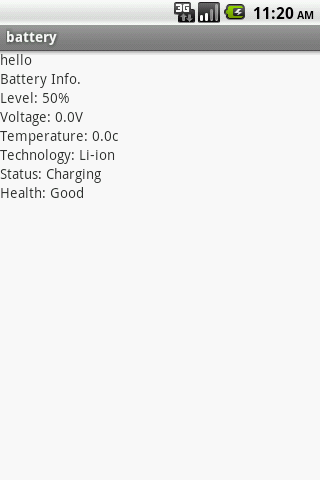The app simple detect battery level, voltage, temperature, technology, charging status, and health of the battery.
Activity
public class MainActivity extends Activity {
private TextView batteryLevel, batteryVoltage, batteryTemperature,
batteryTechnology, batteryStatus, batteryHealth;
/** Called when the activity is first created. */
@Override
public void onCreate(Bundle savedInstanceState) {
super.onCreate(savedInstanceState);
setContentView(R.layout.activity_main);
batteryLevel = (TextView) findViewById(R.id.batterylevel);
batteryVoltage = (TextView) findViewById(R.id.batteryvoltage);
batteryTemperature = (TextView) findViewById(R.id.batterytemperature);
batteryTechnology = (TextView) findViewById(R.id.batterytechology);
batteryStatus = (TextView) findViewById(R.id.batterystatus);
batteryHealth = (TextView) findViewById(R.id.batteryhealth);
this.registerReceiver(this.myBatteryReceiver, new IntentFilter(
Intent.ACTION_BATTERY_CHANGED));
}
private BroadcastReceiver myBatteryReceiver = new BroadcastReceiver() {
@Override
public void onReceive(Context arg0, Intent arg1) {
// TODO Auto-generated method stub
if (arg1.getAction().equals(Intent.ACTION_BATTERY_CHANGED)) {
batteryLevel.setText("Level: "
+ String.valueOf(arg1.getIntExtra("level", 0)) + "%");
batteryVoltage
.setText("Voltage: "
+ String.valueOf((float) arg1.getIntExtra(
"voltage", 0) / 1000) + "V");
batteryTemperature.setText("Temperature: "
+ String.valueOf((float) arg1.getIntExtra(
"temperature", 0) / 10) + "c");
batteryTechnology.setText("Technology: "
+ arg1.getStringExtra("technology"));
int status = arg1.getIntExtra("status",
BatteryManager.BATTERY_STATUS_UNKNOWN);
String strStatus;
if (status == BatteryManager.BATTERY_STATUS_CHARGING) {
strStatus = "Charging";
} else if (status == BatteryManager.BATTERY_STATUS_DISCHARGING) {
strStatus = "Dis-charging";
} else if (status == BatteryManager.BATTERY_STATUS_NOT_CHARGING) {
strStatus = "Not charging";
} else if (status == BatteryManager.BATTERY_STATUS_FULL) {
strStatus = "Full";
} else {
strStatus = "Unknown";
}
batteryStatus.setText("Status: " + strStatus);
int health = arg1.getIntExtra("health",
BatteryManager.BATTERY_HEALTH_UNKNOWN);
String strHealth;
if (health == BatteryManager.BATTERY_HEALTH_GOOD) {
strHealth = "Good";
} else if (health == BatteryManager.BATTERY_HEALTH_OVERHEAT) {
strHealth = "Over Heat";
} else if (health == BatteryManager.BATTERY_HEALTH_DEAD) {
strHealth = "Dead";
} else if (health == BatteryManager.BATTERY_HEALTH_OVER_VOLTAGE) {
strHealth = "Over Voltage";
} else if (health == BatteryManager.BATTERY_HEALTH_UNSPECIFIED_FAILURE) {
strHealth = "Unspecified Failure";
} else {
strHealth = "Unknown";
}
batteryHealth.setText("Health: " + strHealth);
}
}
};
}
XML activity_main.xml
<?xml version="1.0" encoding="utf-8"?>
<LinearLayout xmlns:android="http://schemas.android.com/apk/res/android"
android:orientation="vertical"
android:layout_width="fill_parent"
android:layout_height="fill_parent"
>
<TextView
android:layout_width="fill_parent"
android:layout_height="wrap_content"
android:text="hello"
/>
<TextView
android:layout_width="fill_parent"
android:layout_height="wrap_content"
android:text="Battery Info."
/>
<TextView
android:id="@+id/batterylevel"
android:layout_width="fill_parent"
android:layout_height="wrap_content"
android:text="Battery Level:"
/>
<TextView
android:id="@+id/batteryvoltage"
android:layout_width="fill_parent"
android:layout_height="wrap_content"
android:text="Battery Voltage:"
/>
<TextView
android:id="@+id/batterytemperature"
android:layout_width="fill_parent"
android:layout_height="wrap_content"
android:text="Battery Temperature:"
/>
<TextView
android:id="@+id/batterytechology"
android:layout_width="fill_parent"
android:layout_height="wrap_content"
android:text="Technology:"
/>
<TextView
android:id="@+id/batterystatus"
android:layout_width="fill_parent"
android:layout_height="wrap_content"
android:text="Status:"
/>
<TextView
android:id="@+id/batteryhealth"
android:layout_width="fill_parent"
android:layout_height="wrap_content"
android:text="Health:"
/>
</LinearLayout>





